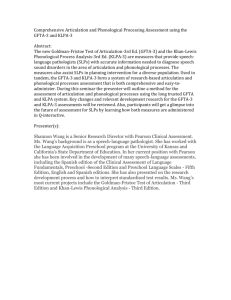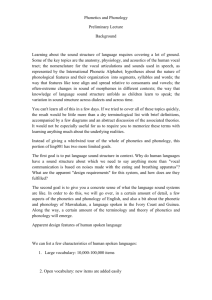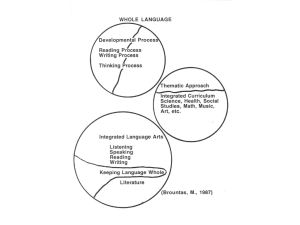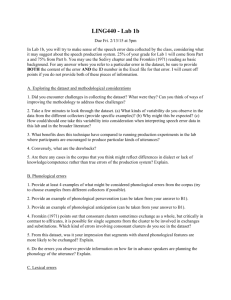783 - جامعة المنيا
advertisement
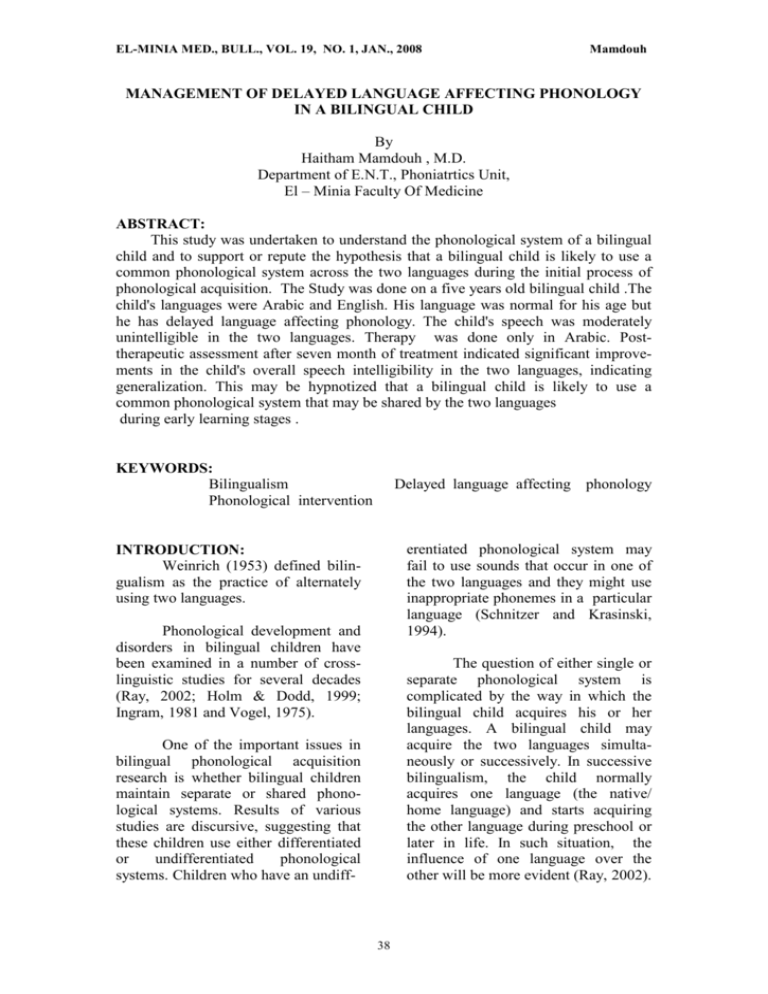
EL-MINIA MED., BULL., VOL. 19, NO. 1, JAN., 2008 Mamdouh MANAGEMENT OF DELAYED LANGUAGE AFFECTING PHONOLOGY IN A BILINGUAL CHILD By Haitham Mamdouh , M.D. Department of E.N.T., Phoniatrtics Unit, El – Minia Faculty Of Medicine ABSTRACT: This study was undertaken to understand the phonological system of a bilingual child and to support or repute the hypothesis that a bilingual child is likely to use a common phonological system across the two languages during the initial process of phonological acquisition. The Study was done on a five years old bilingual child .The child's languages were Arabic and English. His language was normal for his age but he has delayed language affecting phonology. The child's speech was moderately unintelligible in the two languages. Therapy was done only in Arabic. Posttherapeutic assessment after seven month of treatment indicated significant improvements in the child's overall speech intelligibility in the two languages, indicating generalization. This may be hypnotized that a bilingual child is likely to use a common phonological system that may be shared by the two languages during early learning stages . KEYWORDS: Bilingualism Phonological intervention Delayed language affecting phonology erentiated phonological system may fail to use sounds that occur in one of the two languages and they might use inappropriate phonemes in a particular language (Schnitzer and Krasinski, 1994). INTRODUCTION: Weinrich (1953) defined bilingualism as the practice of alternately using two languages. Phonological development and disorders in bilingual children have been examined in a number of crosslinguistic studies for several decades (Ray, 2002; Holm & Dodd, 1999; Ingram, 1981 and Vogel, 1975). The question of either single or separate phonological system is complicated by the way in which the bilingual child acquires his or her languages. A bilingual child may acquire the two languages simultaneously or successively. In successive bilingualism, the child normally acquires one language (the native/ home language) and starts acquiring the other language during preschool or later in life. In such situation, the influence of one language over the other will be more evident (Ray, 2002). One of the important issues in bilingual phonological acquisition research is whether bilingual children maintain separate or shared phonological systems. Results of various studies are discursive, suggesting that these children use either differentiated or undifferentiated phonological systems. Children who have an undiff- 38 EL-MINIA MED., BULL., VOL. 19, NO. 1, JAN., 2008 In the past, a number of studies have dealt with the fact that a developing bilingual child uses either one or two systems of phonology. Studies have supported that bilingual children develop two separate phonological systems e.g (Holm & Dodd, 1999; Dodd et al., 1997; Genesee 1989; Pye, 1986; Ingram, 1981 and Lindholm & Padilla, 1978). Studies have also supported the opposite view that bilingual children are likely to use a single phonological system in the early stages of learning e.g (Ray, 2002; Gildersleeve et al., 1996; Vihman, 1982; Redlinger & Park, 1979 and Swain, 1972). Many studies reported in the literature deal with initial one-system and two– systems phonology later on e.g (Yavas, 1995; Vihman, 1985; Volterra & Taeschner, 1978 and Imedadze, 1967). Mamdouh unlike balanced bilinguals who acquire languages simultaneously. Even balanced bilinguals, having native like language proficiency, show traces of interference in one or both of their native language. Bilingual children tend to make the same type of errors in both languages and a single deficit underlies disorders in the two phonological systems of the child (Holm and Dodd, 1999). Holm and Dodd (1999) studied a Punjabi- English speaking child whose speech was characterized by inconsistent errors in both languages. After therapy, it was found that intelligibility of the child's speech improved in both languages even though therapy had only been provided in English. There is a very shortage in the researches studying management of phonological errors in whom Arabic language is one of the two languages they acquire. Vogel (1975) studied a Romanian - English child and stated that the child was using a single phonological system for the two languages, as the child demonstrated the same phonological processes when using both languages. Watson (1991) supported the existence of an initial "averaged" system (combining characteristics of the two phonological systems) that slowly differentiates into two separate systems of phonology later on. In a study with bilingual children having different language histories, Vihman (1985) noted that a gradual differentiation of linguistic systems occurs during the third year of life. Schnitzer and Krasinski (1994) supported the existence of a single phonological system until around the age of two years, seven months at which the preexisting phonological system differentiates into two distinct systems. AIM OF THE WORK : The aim of this work was to understand the phonological system of a bilingual child and to support or refute the hypothesis that a bilingual child is likely to use a common phonological system across the two languages during the initial process of phonological acquisition i.e if management of phonological errors in a bilingual child is monitored in only one language, generalization would or would not occur to the child's other language. MATERIAL AND METHODS : Subject : The child (MA) was a fiveyear-old boy born in kingdom of Saudi Arabia. His father is Saudi (speaks Arabic) and his mother is from United States (Speaks English). As reported Subordinate bilinguals, who acquire languages successively, are 39 EL-MINIA MED., BULL., VOL. 19, NO. 1, JAN., 2008 by MA's parents, MA was encouraged to speak in both Arabic and English almostly in the same degree. He had normal pre-, peri- and post-natal history and he did not demonstrated any neurological or hearing problems as reported by his parents. Mamdouh Two measures were taken from each sample: (a) Percentage Consonants Correct (PCC) on utterances, (b) Speech Intelligibility (SI). To calculate the PCC, the number of correct consonant productions was divided by the total number of consonants in the target words and multiplied by 100 (Shriberg and Kwiatkowski, 1982). To calculate SI we used a five – point rating scale (Ray, 2002): the highest rank, 4, indicates that speech is intelligible and can be understood 100% of the time; 3 indicates speech is minimally impaired and can be understood 70 – 90% of the time; 2 indicates speech is mildly impaired and can be understood 50 – 70% of the time; 1 indicates moderately impaired speech that can be understood 30 – 50% of the time and 0 indicates severely impaired speech that can be understood 10 – 30% of the time. During MA's first visit to the clinic, he appeared to be very attentive and cooperative. Language evaluation using Arabic Language Test (Kotby et al., 1995) revealed that his language (receptive part of the semantics, expressive part of the semantics, receptive part of the syntax, expressive part of the syntax and pragmatics) was normal for his age. Testing phonology by Articulation test (Kotby et al., 1985) revealed that he had multiple phonological substitutions. Vocal tract examination revealed no organic lesions such as bite anomaly or tongue tie. IQ assessment using Stanford Binet Intelligence scale (Binet, 1937) was 89. hearing was also within normal limits as indicated by pure- tone audiometry and tympanometry. Intervention : Intervention focused on the Arabic language only. Correction was done in four steps: / s / and /∫/ sounds, followed by / ħ / and / x / sounds, then / k / sound and lastly correction of voiced sounds / z / , / / , / g / , / h / , / ʁ /, / d / and / ʕ /. After the end of each step, two speech samples were collected from each of the two languages to tape the progress made by the child, based on Percentage Consonant Correct (PCC) and Speech Intelligibility (SI) to examine wheather generalization to English language has taken place or not. Pre-intervention Assessment: Before intervention, baseline measurements in articulation and phonology were obtained by two methods: 1. Articulation Test (Kotby et al., 1985) for Arabic language and Goldman-Fristoe Test of Articulation (Goldman and Fristoe, 1986) for English language. 2. Collecting two naturalistic speech samples for each of the two languages. Speech was elicited in a variety of contexts: with story books, pictures and toys. The aim was to obtain a sample which was representative of the subject's communication competence in conversation. Each sample contained an average of 175 – 200 words. Training program: The therapy was done in the following program: * The child is made aware of the characteristics of the standard phoneme. 40 EL-MINIA MED., BULL., VOL. 19, NO. 1, JAN., 2008 * The child is got sensoriperceptual training to assist him to compare his error with the normal speech. * Production of the standard sound. * Stabilization and strengthen the use of the standard sound in isolation, in syllable, in words then in phrases and sentences. * The use of the target sound in spontaneous speech. Bowen and Cupples (1998), in detailed case study, noted that the strength of phonological therapy depends on family education, multiple exemplar techniques and home- work. Therefore, MA's father was asked to spend some time each day going over the tasks have observed during therapy. He was instructed to correct those words produced incorrectly in Mamdouh spontaneous speech. In order to tape the generalization of treatment to the English language, the father was asked to monitor errors production only in Arabic language and the mother was asked to ignore the monitoring of the English language at home. Total number of treatment sessions was forty– three. The first step of intervention took eleven sessions, the second step took nine sessions, the third step took eight sessions and the fourth and last step took fifteen sessions. The duration of each session was thirty minutes. Two sessions were scheduled per week. Therapy was continued for about seven consecutive months. RESULTS: Results of pre-intervention Articulation Tests for Arabic and English Languages: Phonemes Replaced by / s /, / ʃ / , / z /, / ʤ / / k /, / g /, / d / / ħ /, / x / , / h /, / ʁ /, / ʕ / /v/ / r/ Interdental /t/ /ʔ/ /f/ /l / Results of assessment after each step of therapy: Baseline 1st step 2nd step 3rd step 4th step PCC SI PCC SI PCC SI PCC SI PCC SI Arabic Language English Language 37% Rate (1) 48% Rate (1) 55% Rate (2) 59% Rate (2) 96% Rate (4) 47% Rate (1) 59% Rate (1) 59% Rate (2) 73% Rate (3) 95% Rate (4) 41 EL-MINIA MED., BULL., VOL. 19, NO. 1, JAN., 2008 Mamdouh DISCUSSION: Diagnosis of phonological disorders in children acquiring two or more languages is highly problematic because knowledge concerning the phonological structure of many languages is limited (Holm et al., 1999). Phoniatricians and related professionals should be aware of differences between bilingual and monolingual phonological acquisition patterns (Watson, 1991). phonological errors as his language was well developed . It is also necessary to understand the difference between normal and disordered patterns of bilingual phonological development. Abnormal phonological patterns must be detected using transcription that contain sufficient details to represent the child's entire phonological system, as influenced by one or more languages. The entire phonological system should be considered for assessment and interactive intervention. All phonemes of the languages should be assessed in different word positions. In assessing the phonological development of a bilingual child, the two languages spoken by the child should be the focus of attention, irrespective of the treatment choice (Ray, 2002) . Based on the phonological patterns obtained from the pre – intervention Articulation Tests for Arabic and English languages, it was hypothesized that MA was using a unified phonological system. MA's phonemes, were substituted in a similar way in the two languages. Gildersleeve et al., (1996), based on their observation of common phonological system in Spanish –English bilinguals, also emphasized that bilingual children tend to use an amalgamated phonological system. As reported by Stow and Pert (1998), analysis of spontaneous speech samples are highly recommended . Phonological assessment of MA's speech samples in the two languages indicated that the child had phonological errors that interfered significantly with speech intelligibility in the two languages . MA's Percentage Consonant Correct (PCC) and Speech Intelligibility (SI) after each step of therapy are improved in the two languages. PCC did not improved in English language after the second step of therapy because in this step of therapy we corrected / ħ / and / x / sounds which are Arabic sounds. In this study, MA was a balanced bilingual child, as he was encouraged to speak in both Arabic and English languages almostly in the same degree. The successful treatment of MA's phonological disorder required forty –three sessions. Therapy was continued for about seven consecutive months. This was coupled with regular work at home under supervision of the father. During therapy, MA showed very good self correction skills. Shriberg and Kwiatkowski (1990) revealed that several factors contributed to successful therapy of phonological disorders: parental input, Language evaluation of MA using Arabic Language Test (Kotby et al., 1995) revealed that his language was normal for his age. Testing phonology by Articulation Tests for Arabic and English Languages revealed that he had multiple phonological errors. Diagnosis of MA was delayed language affecting phonology, so, we could start correction of 42 EL-MINIA MED., BULL., VOL. 19, NO. 1, JAN., 2008 reinforcement schedules, intensive therapy blocks without gaps and enhancement of self monitoring skills. Mamdouh thorough assessment of the two languages spoken by a bilingual child needs to be performed in order to understand the nature of overall phonological deficits. The results of this study indicated that the effects of phonological therapy in Arabic language were able to generalize to English language. If the treatment had a positive impact in Arabic language only, then the underlying phonological systems would have been existing as separate entities. However, because treating only one language had a positive outcome on the other language, it can be assumed that the two phonological systems were combined into one in MA's case. This data supports the existence of a single phonological system. CONCLUSIONS: * Bilingual child is likely to use a common phonological system that may be shared by the two languages during early learning stages. * It is not essential to treat phonological errors in all languages spoken by the child as treatment in one language will be generalized in the other languages. REFERENCES: 1. Binet, S. (1937): Manual of Stanford Binet test of general intelligence: Translated to Arabic by Kabain, I., Cairo University (pp.34-52). 2. Bowen, C., & Cupples, L. (1998): A tested phonological therapy in practice. Child Language Teaching and Therapy, 14, 1, 2950. 3. Dodd, B., Holm, A., & Li, W. (1997): Speech disorder in preschool children exposed to Cantonese and English. Clinical Linguistics & Phonetics, 11, 229-243. 4. Genesee, F. (1989): Early bilingual development: One language or two? Journal of Child Language, 16, 161-179. 5. Gildersleeve, C., Davis, B., & Stubbe, E. (1996): When monolingual rules do not apply: Speech development in a bilingual environment. Paper presented at the American Speech Language-Hearing Association Convention, Seattle, WA. 6. Goldman, R., & Fristoe, R. (1986): Goldman-Fristoe Test of Articulation. Circle Pines, MN: American Guidance Service. 7. Holm, A., & Dodd, B. (1999): An intervention case study of a bilingual child with a phonological This finding is supported by Ray (2002) in his study on a trilingual child with multiple phonological errors in the three languages, therapy was done in English only and posttherapeutic assessment indicated significant improvements, in the child's overall speech intelligibility in all three languages, indicating generalization. The findings in this study are also supported by Holm and Dodd (1999). They assumed that bilingual children are likely to use the same phonological planning to process phonology of each language, therefore, generalization is likely to occur. Surprisingly/ v / which is an English sound and not found in Arabic was replaced by the voiceless sound / f / in MA's speech . After the fourth step of therapy, It was found that /v / sound was corrected and this indicates also generalization . In light of the present study, it is not essential to treat all languages spoken by the child. However, a 43 EL-MINIA MED., BULL., VOL. 19, NO. 1, JAN., 2008 disorder. Child Language Teaching & Therapy, 15, 139-158. 8. Holm, A., Dodd, B., Stow, C., & Pert, S. (1999): Identification and differential diagnosis of phonological disorders in bilingual children. Language Testing, 16(3), 271-292. 9. Imedadze, N. A. (1967):On the phonological nature of child's speech formation under condition of exposure to two languages. International Journal of Psychology, 2, 129-132. 10. Ingram, D. (1981): Procedures for the phonological analysis for children's language. Baltimore: University Park Press. 11. Kotby, M.N., Bassiouny, S., ElZomor, M. and Mohsen, E. (1985): Pilot study for standardization of an Articulation test . 12. Kotby, M.N., Khairy A., Barakah, M., Rifaie, N. and ElShobary, A. (1995) : Language testing of Arabic speaking children. Proceedings of the XXIII World Congress of International Association of Logopaedics and Phoniatricians, Cairo, August, 6-10. 13. Lindholm, K. J., & Padilla, A. M. (1978): Language mixing in bilingual children. Journal of Child Language, 5, 327-335. 14. Pye, C. (1986): One lexicon or two?: An alternative interpretation of early bilingual speech. Journal of Child Language, 591-593. 15. Ray, J. (2002): Treating phonological disorders in a multilingual child: A case study. American Journal of Speech – Language Pathology, 11, 305-315. 16. Redlinger, W. E., & Park, T. (1979): Language mixing in young bilinguals. Journal of Child Language, 7, 337-352. 17. Schnitzer, M. L., & Krasinski, E. (1994): The development of segmental phonological production in a bilingual child. Journal of Child Language, 21, 585-622. Mamdouh 18. Shriberg L. D., & Kwiatkowski, J. (1982): Phonological disorders III: A Procedure for assessing severity of involvement. Journal of Speech and Hearing Disorders, 47, 242- 256. 19. Shriberg, L. D., & Kwiatkowski, J. (1990): Self-monitoring and generalization in preschool speech-delayed children. Language, Speech, and Hearing Services in Schools, 21,157-170. 20. Stow, C., & Pert, S. (1998): The development of a bilingual phonology assessment. International Journal of Language & Commu-nication Disorders, 33, 338-342. 21. Swain, M. (1972): Bilingualism as a first language. Journal of Child Language, 12, 297-324. 22. Vihman, M. M. (1982): The acquisition of morphology by a bilingual child: A whole-word appro-ach. Applied Psycholinguistics,3,141-160. 23. Vihman, M. M. (1985): Language differentiation by the bilingual infant. Journal of Child Language, 12, 297-327. 24. Vogel, I. (1975): One system or two: An analysis of a two-year old Romanian-English bilingual's phonology. Papers and Reports on Child Language Development, 9, 43-62. 25. Volterra, V., & Taeschner, T. (1978): The acquisition and development of language by bilingual children. Journal of Child Language, 5, 311-326. 26. Watson, I. (1991): Phonological processing in two languages. In E. Bialystok (Ed.), Language processing in bilingual children. Cambridge: Cambridge University Press. 27. Weinreich, U. (1953): Languages in contact: Findings and problems. New York: Linguistic Circle of New York. 28. Yavas, M. (1995): Phonological selectivity in the first fifty words of a bilingual child. Language and Speech, 38, 189-202. 44 Mamdouh EL-MINIA MED., BULL., VOL. 19, NO. 1, JAN., 2008 عالج تأخر التركيب الصوتي للغة فى طفل ثنائي اللغة هيثم ممدوح محمد قسم األنف واألذن والحنجرة -وحدة التخاطب كلية الطب – جامعة المنيا تمت هذه الدراسة على طفل ثنائي اللغة ينطق اللغةة الررييةة إلاجنيليةيةة إليرةانى مةر تة ر فى التركيب الصإلتي للغتير حيث تم تصليح األ طاء الفإلنإللإليية عند الطفل عر طريق يلسات ت اطب استمرت حإلالي سيرة شهإلر ياست دام اللغة الرريية فقط ،إلفى نهايةة اليرنةاما الرييةي إليةةد ر إلحةةإلك الكةةيم نةةةد تحسةةر إلاأل طةةاء الفإلنإللإلييةةة ا تفةةةت فةةى كلتةةا اللغتةةير الررييةةةة إلاجنيليةية مما ند يرطى داللة على ار الطفل ثنائي اللغة يقإلم ياست دام نظام فإلنإللإليي (نظةام تركيب صإلتي) مشترك لكلتا اللغتير فى المراحل األإللى لترلم اللغة . 45

